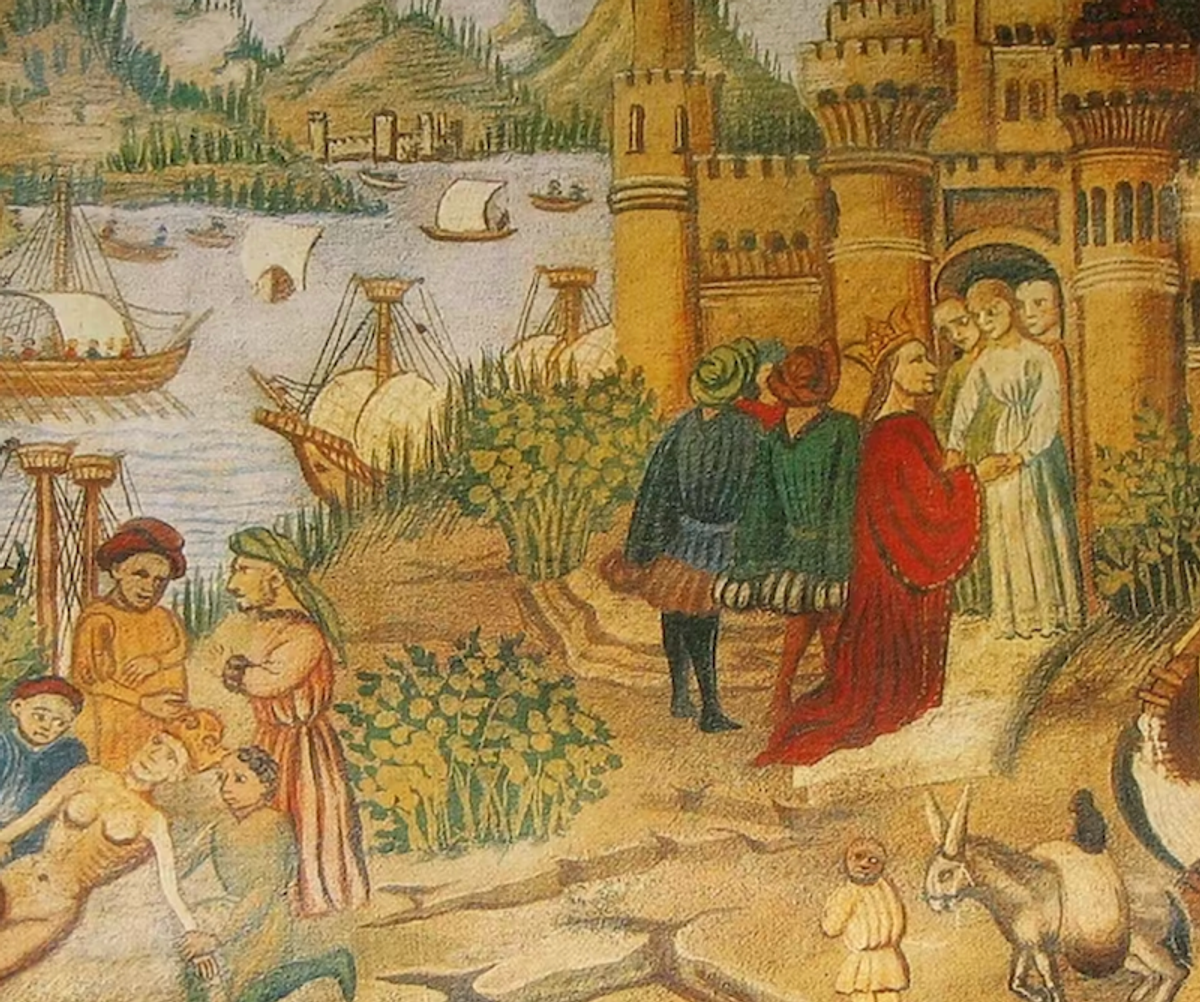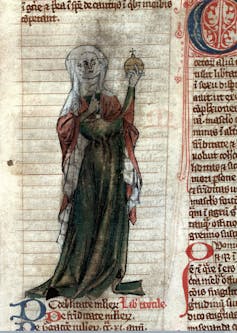The Conversation
February 13, 2023

The medical school of Salerno as it appears in a miniature of Avicenna’s Canon. The image represents the legendary story of Robert, Duke of Normandy. Mortally wounded by an arrow, he was heroically saved by his wife who sucked out the poison as prescribed by the physicians of Salerno. Wikipedia
In seeking to tell the story of these experts (prior to their ostracization from the practice), researchers have come up against a number of obstacles. The information available comes primarily from scarce, disparate fragments from biographical sources, as well as economic, legal and administrative ones. Sometimes all that remains is a given name or a surname, such as in the case of the women listed in the Ars Medicina of Florence (a medical treatise) or of the nun apothecary Giovanna Ginori, whose name can be found in the tax records of the pharmacy where she worked in the 1560s.
Such painstaking research has nevertheless helped us better understand how a male-dominated, institutional and hierarchical system has pushed women away from the practice and study of medicine.
The Schola Salernitana
Our first port of call in this story is a once-renowned medical school that operated in Salerno in the 9th and 10th centuries. The Schola Salernitana was an institution attended by many women, including the pioneering gynaecologist and surgeon known as Trota (or Trotula) (13th century), the surgeon and eye specialist, e.g. Costanza Calenda (15th century), doctor Abella di Castellomata (14th century), or Rebecca Guarna (14th century). Information about these women is still scarce and being sorted out by researchers: it is complicated to separate real data from legend. The above are nevertheless some of the better-documented figures. Also active during the Middle Ages, the group of the mulieres salernitanae left a mark, too.
Unlike the women doctors at the school, the mulieres worked using more empirical methods, then submitted their remedies to the school’s doctors, who decided whether to accept them. Evidence of this can be found in the manual Practica Brevis, written by Giovanni Plateario, and in the writings of Bernard de Gordon. Located to the South of Naples, Salerno was a city where Christian, Jewish and Muslim scholars came together, turning the school into an exceptional melting pot of scientific encounters and influences.

A woman doctor, possibly Trotula of Salerno, holding a flask of urine. Miscellanea medica XVIII, Folio 65 recto (=33 recto), early 14th century. Wikimedia
Women accused of illegal medical practice
However, from 1220 onward, it became no longer possible to practise medicine without a diploma from the University of Paris or approval from its doctors and chancellor, pushing female doctors to the margins. Failure to comply with the new instructions resulted in expulsion from the field, which is exactly what happened to a woman doctor named Jacqueline Felice de Almania. According to the 1322 document produced by the University of Paris, she had been treating patients without any “real” knowledge of medicine (i.e., without a university education). She was subjected to expulsion and had to pay a considerable fine. The records of the dispute describe the medical examinations performed by Jacqueline, noting how she had analyzed urine by sight, taken her patients’ pulses, probed their limbs, and treated male patients. This is one of the rare pieces of evidence that mentions the fact that women doctors also treated men.
The young doctor’s trial took place at a time when medical practitioners without university degrees were being denounced and sentenced. Before her came Clarice of Rouen was also banned from practicing medicine for treating men, followed by more women medical experts in 1322, recorded as Jeanne the Convert of Saint-Médicis, Marguerite of Ypres and the Jewess Belota.
In 1330, several rabbis in Paris were also accused of illegally practicing the art of medicine, along with other “healers” who posed as experts without truly being so according to the authorities. All were branded as frauds, even if they had been performing competently. In 1325, Pope John XXII had received a prompt appeal from the professors of the University of Paris following the Clarice affair. Upon this, he wrote to Bishop Stephen of Paris ordering him to forbid the practice of medicine by women without medical knowledge and by midwives in Paris and the surrounding areas, warning that these women were in fact practising witchcraft https://www.carocci.it/prodotto/anima-e-corpo.
The formalization of medical studies
The gradual prohibition on women practicing medicine coincided with the creation of a formalized academic canon in the field. This marked the beginning of a careful vetting process by the teaching authorities and guilds, which served to marginalise women doctors even further.
However, this did not wipe them entirely from existence or from the practice, given that a reasonable number of names can be found in the Italian records alone. These include Monna Neccia, mentioned in the Estimo tax register in 1359, and Monna Iacopa, who treated plague victims in 1374. Both were from Florence, as were the ten women enrolled between 1320 and 1444 in the city’s guild of doctors, the Arte dei Medici e degli Speziali. In records from Siena, Tuscany, we find mention of Agnese and Mita, who were remunerated by the city for their services in 1390 https://www.carocci.it/prodotto/anima-e-corpo.
All the same, it had become very dangerous for women to practice medicine, particularly due to the ever-mounting suspicions of witchcraft.
There is an unfortunate lack of data about these women in the official sources, given that they practiced at a time when society permitted only men to access more senior positions.
Despite all this, the historical background that we have pieced together points to an existence both of women experts who practiced the art of medicine and of women doctors who had studied their craft, often on an unofficial basis, with their father, brother or spouse.
Medieval women doctors in literature
Non-institutional sources, such as literary texts, have proven extremely valuable to this research. Boccaccio, for instance, mentions a woman doctor in the Decameron. The narrator, Dioneo, recounts the tale of a certain Gillette of Narbonne, a gifted doctor who became betrothed to her beloved Bertrand de Roussillon as a reward for curing the King of France of a fistula in his chest. Boccaccio’s characterization of Gillette is patently aware of the monarch’s lack of trust in her, both as a woman and as a “damsel”. Addressing the King, she says:
“Great King, let not my skill and experience be despised because I am young and a maiden, for my profession is not physic, neither do I undertake the administering thereof, as depending on my own knowledge ; but by the gracious assistance of Heaven, and some rules of skillful observation which I learned of reverend Gerard of Narbonne, who was my worthy father and a physician of no mean fame all the while he lived.”
Boccaccio describes this woman medical expert in straightforward, natural terms. This is perhaps because, contrary to the current general belief, he was speaking of a rather common situation that would be recognized by his readership. Gillette’s words are indicative of a reality for women medical practitioners at the time: she had learned her craft from her father.
There is also a great deal of information about Jewish women doctors operating mainly in southern Italy and Sicily, who learned the medical arts from their family.
The University of Paris played a pivotal role in the historical process of normalizing and institutionalizing the medical profession. In her article Women and Healthcare Practices in the Plea Register of the Parliament of Paris, 1364–1427, Geneviève Dumas underlines the importance of Parisian legal sources from the 14th and 15th centuries, which remember the women who were sentenced for illegally practicing medicine or surgery. Dumas chronicles two trials in her writings: one carried against Perette la Pétone, a surgeon, and another against Jeanne Pouquelin, a barber (as barbers at the time were permitted to perform certain surgical procedures).
As the study of medicine at the University of Paris became the only valid medical education in Europe and the Schola Salernitana saw its influence wane, women were gradually excluded from these professions.
The gradual disappearance of women doctors in the Medieval period can be linked to bans imposed by the Church, as well as to the progressive professionalization of the medical field, which saw the creation of more rigorous institutions such as universities, arts societies and guilds, all founded and controlled by men.
In Europe, it was not until the mid 19th century that the first university-qualified women doctors were able to practise their profession. Even then, they still had to face more than their fair share of criticism.

Isabella Gagliardi, Professeur Associé d’Histoire du christianisme, Fondation Maison des Sciences de l'Homme (FMSH)
This article is republished from The Conversation under a Creative Commons license. Read the original article.
No comments:
Post a Comment